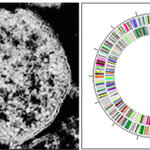Applied Physics

USC computer scientist Kristina Lerman thinks she has found a new source of artificial intelligence computing power to solve difficult IT problems of information classification, reliability, and meaning - people.
She says that extracting 'metadata' about transactions -- who is talking to whom, who is listening, how conclusions are reached, and how they spread -- can help researchers answer currently refractory problems about documents: their accuracy and quality, their categorization, the relation of their embedded terminology.
One benefit, according to Lerman, who in addition to her ISI…

Researchers have discovered that calcium ions could play a crucial role in multiple sclerosis by activating enzymes that degrade the fatty sheath that insulates nerve fibers.
Learning exactly how the myelin sheath is degraded might enable scientists to determine how to halt disease progress and reverse damage by growing new myelin, said Ji-Xin Cheng, an assistant professor in Purdue University's Weldon School of Biomedical Engineering and Department of Chemistry.
"Although multiple sclerosis has been studied for many years, nobody knows exactly how the disease initially begins," he said. "The…

A £9.2m research centre at the University of Nottingham will break new ground in our understanding of plant growth and could lead to the development of drought-resistant crops for developing countries.
The Centre for Plant Integrative Biology (CPIB) will focus on cutting-edge research into plant biology — particularly the little-studied area of root growth, function and response to environmental cues.
A greater understanding of plant roots, particularly how they respond to different levels of moisture, nutrients and salt in the soil, could pave the way for the development of new drought-…

Researchers have used nanotechnology to create transparent transistors and circuits, a step that promises a broad range of applications, from e-paper and flexible color screens for consumer electronics to "smart cards" and "heads-up" displays in auto windshields.
The transistors are made of single "nanowires," or tiny cylindrical structures that were assembled on glass or thin films of flexible plastic.
"The nanowires themselves are transparent, the contacts we put on them are transparent and the glass or plastic substrate is transparent," said David Janes, a researcher at Purdue University's…

18-year old Nicholas Tan Xue-Wei will soon depart for the U.S. to present a research paper at The 2007 World Congress in Computer Science, Computer Engineering, and Applied Computing (WORLDCOMP'07), June 25 to 28, in Las Vegas.
Before returning home to Singapore, Nicholas will continue to represent Singapore's Bioinformatics Institute by presenting his research paper at the World Congress on Engineering 2007 (WCE 2007), July 2 to 4 in London.
Nicholas will speak about his research paper, titled “Towards A Serum-Free Medium: Growth Receptors And Signaling Pathways That Regulate Multipotency In…

Sarah Everts from Chemical and Engineering News has just published an article about chemistry activities in Second Life. Drexel Island got a mention:
My avatar was then deposited at a place in Second Life called Orientation Island. As I walked my avatar into a geodesic information dome, I happened to notice the "Fly" button. Intrigued, I wasted no time pressing it—and I shot up into the air, hitting the ceiling of the information dome like a clumsy goth-bird. It was around this time that Horace Moody, the avatar of a real-life chemist at Drexel University named Jean-Claude Bradley, came to…

Bacteria called Dehalococcoides Ethenogenes, discovered in Ithaca sewage sludge in 1997 by James Gossett, Cornell professor of civil and environmental engineering, are now in wide use to detoxify some carcinogenic chemicals but they could be used for a lot more.
These bacteria remove chlorine atoms from molecules and leave less-toxic compounds behind in toxic waste like perchloroethylene (PCE) and trichloroethylene (TCE).
But D. ethenogenes strains work well at some sites and not so well at others, and nobody knows why.
The bacterium Dehalococcoides ethogenes can extract chlorine from…

Satellite tracking software freely available on the Internet and a smattering of textbook physics could be used by any organisation that can get hold of an intermediate range rocket to mount an unsophisticated attack on military or civilian satellites. Such an attack would require modest engineering capability and only a limited budget.
A terrorist organisation or rogue state could threaten essential satellite systems, say Adrian Gheorghe of Old Dominion University Norfolk, in Virginia, USA and Dan Vamanu of "Horia Hulubei" National Institute of Physics and Nuclear Engineering, in Bucharest,…

Biomedical engineers at Duke's Pratt School of Engineering have adapted a three-dimensional ultrasound scanner that might guide minimally invasive brain surgeries and provide better detection of a brain tumor’s location.
The “brain scope,” which is inserted into a dime-sized hole in the skull, may be particularly useful for the bedside evaluation of critically ill patients when computed tomography (CT) and magnetic resonance imaging (MRI) equipment is unavailable, the researchers said.
Brain surgeons now rely primarily on two-dimensional images produced by MRI or ultrasound, said Edward…

Researchers at Sandia National Laboratories in California have emerged as key players in a state-of-the-art program for the U.S. Army that focuses on the design and manufacturing of a lightweight, high-caliber, self-propelled cannon system.
The weapon system, known as the Non-Line-of-Sight Cannon (NLOS Cannon) is fully automated and can fire at a sustained rate of six rounds per minute. The vehicle, once completed, must be light and agile enough to fit three vehicles comfortably onto a C-17 cargo aircraft.
According to Sandia researcher Nipun Bhutani, who serves as project manager for the lab…